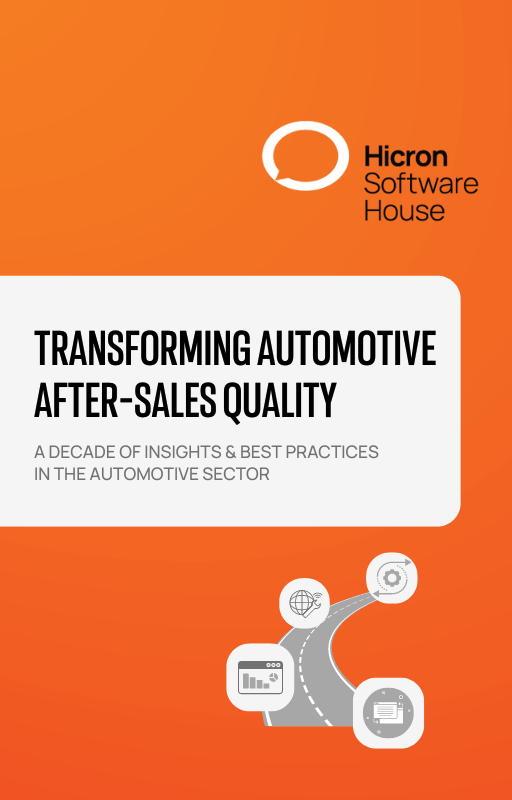
The automotive industry is undergoing a profound transformation driven by rapid technological advancements. Innovations in the Internet of Things (IoT), Artificial Intelligence (AI), and digital platforms are reshaping how vehicles are designed, manufactured, and experienced. These technologies are not only enhancing vehicle performance and safety but are also revolutionizing customer experiences and operational efficiencies.This also applies to automotive after-sales.
The importance of digital transformation
Digital transformation is very important in this evolving landscape. As consumer expectations rise and competition intensifies, automotive companies must embrace digital change to stay competitive. From connected cars that offer personalized user experiences to AI-driven predictive maintenance systems, adopting these technologies is essential for maintaining market relevance and driving business growth.
Challenges of managing legacy systems
However, the journey toward digital transformation is fraught with challenges. One significant hurdle is managing existing legacy systems while integrating new technologies. Many automotive companies rely on outdated infrastructure that is not easily compatible with modern innovations. This creates complexities in ensuring smooth operations and maintaining data integrity during the transition period.
Benefits of a gradual approach
A balanced, gradual approach to digital transformation can help mitigate these challenges. By taking incremental steps, companies can minimize risks associated with abrupt changes and ensure seamless transitions. This strategy allows for continuous improvement and adaptation, ultimately leading to a more resilient and future-proof organization. Embracing a phased integration of new technologies ensures that the benefits of innovation are realized without compromising stability and performance.
Step 1: Conduct a comprehensive assessment
Evaluate current systems and processes:
- Analyze existing operations, workflows, and technologies: Begin by thoroughly examining your current operations, workflows, and technologies. This evaluation will help you gain a clear understanding of the strengths and weaknesses within your organization.
- Map out areas for digitalization: Identify the areas within your existing processes that would benefit most from digital transformation. This could include aspects such as efficiency improvements, cost reductions, or enhanced customer experiences.
Understand stakeholder needs:
- Engage with employees, customers, and partners: To ensure a successful digital transformation, it’s crucial to gather insights from all key stakeholders. Conduct surveys, interviews, and focus groups to understand their needs, pain points, and expectations.
- Prioritize high-impact areas: Focus your digital transformation efforts on areas that have the highest impact and align closely with your business goals. Prioritizing these areas will help you achieve meaningful improvements and build momentum for further digital initiatives.
Step 2: Define clear objectives and goals
Set specific, measurable goals:
- Establish short-term and long-term objectives: Develop clear and specific objectives for each phase of your digital transformation. These should encompass both short-term wins and long-term strategic goals, ensuring a balance between quick gains and sustainable growth.
- Alignment with business strategy: Ensure that all goals are not only achievable but also closely aligned with your overall business strategy. This alignment will help maintain focus and coherence throughout the transformation process.
Develop a roadmap:
- Create a detailed plan: Construct a comprehensive roadmap that outlines the phases, timelines, required resources, and key milestones for your digital transformation. This plan should serve as a guide to navigate through the complexities of the transformation process.
- Include checkpoints: Incorporate regular checkpoints within your roadmap to evaluate progress and make necessary adjustments. These checkpoints will enable you to stay on track, address any issues promptly, and refine your strategy based on real-time feedback and outcomes.
Step 3: Start with small, high-impact projects
Pilot programs:
- Implement pilot projects: Begin by rolling out pilot projects in targeted areas like Customer Relationship Management (CRM), e-commerce platforms, or predictive maintenance tools. These initial projects should be manageable and capable of demonstrating the value of digital transformation.
- Focus on quick wins: Select initiatives that offer quick wins and deliver measurable benefits. These early successes can build momentum, foster stakeholder buy-in, and provide valuable insights for larger-scale implementations.
Measure and analyze outcomes:
- Track performance using KPIs: Monitor the performance of your pilot projects using key performance indicators (KPIs). Regularly assess these metrics to gauge the success and impact of the initiatives.
- Refine strategies based on data insights: Use the data collected from your pilot projects to refine your strategies. Analyzing outcomes will help identify what works well and where adjustments are needed, ensuring a more effective approach before scaling up to broader implementations.
Step 4: Invest in training and skill development
Upskill existing workforce:
- Provide training on new digital tools and technologies: Equip your current employees with the necessary skills by offering comprehensive training on new digital tools and technologies. This will help them adapt to changes and enhance their productivity.
- Encourage continuous learning: Foster a culture of continuous learning within your organization. Encourage staff to stay updated on the latest advancements and trends in technology, ensuring they remain competitive and proficient in their roles.
Hire skilled talent:
- Recruit experts in digital transformation: To address skill gaps, recruit professionals with extensive experience in digital transformation. These experts can provide valuable insights and drive the implementation of new initiatives.
- Balance internal talent and external expertise: Strive for a balance between nurturing your internal talent and bringing in external expertise. This approach ensures you leverage the strengths of your existing workforce while benefiting from fresh perspectives and specialized skills.
Step 5: Integrate technologies gradually
Phased integration:
- Implement new technologies in stages: Adopt a phased approach to integrating new technologies. This strategy ensures smooth transitions and allows your organization to adapt incrementally.
- Start with non-critical systems: Begin by implementing new technologies in non-critical areas. Once these systems are successfully integrated, gradually move on to core operations. This minimizes disruptions and allows for continuous learning and adjustment.
Ensure compatibility:
- Focus on interoperability with legacy systems: Prioritize making new technologies compatible with your existing legacy systems. Ensuring interoperability will help maintain operational continuity and data integrity.
- Use middleware and APIs: Employ middleware and APIs to facilitate integration. These tools can bridge the gap between old and new systems, enhancing functionality and ensuring seamless operation across different platforms.
Step 6: Monitor progress and adapt
Regular reviews and adjustments:
- Conduct periodic reviews: Schedule regular reviews to evaluate the progress of your digital transformation efforts. Use these assessments to identify areas that require improvement and ensure that objectives are being met.
- Flexibility and adaptation: Be prepared to adapt your plans based on real-time data and feedback. Flexibility is crucial in responding to evolving challenges and opportunities, allowing for timely adjustments that keep the transformation on track.
Continuous improvement:
- Embrace an iterative approach: Adopt an iterative mindset, continuously refining processes and technologies. This approach fosters ongoing development and enhancement, ensuring that your organization remains agile and responsive.
- Leverage lessons learned: Utilize insights and lessons learned from each phase of the transformation to inform subsequent steps. Building on past experiences will help you make more informed decisions and drive continuous improvement throughout the process.
Step 7: Foster a culture of innovation
Encourage experimentation:
- Create an empowering environment: Foster a workplace culture where employees feel empowered to experiment and innovate. Encourage them to explore new ideas, take calculated risks, and think creatively.
- Recognize and reward success: Acknowledge and celebrate successful initiatives to promote a culture of innovation. Providing recognition and rewards for innovative efforts will motivate employees and reinforce the value of their contributions.
Communicate vision and benefits:
- Articulate the vision: Clearly communicate the vision and long-term benefits of digital transformation to all stakeholders. Ensure that everyone understands how these changes align with the overall business strategy and objectives.
- Build buy-in and support: Demonstrate how digital transformation meets business goals and addresses customer needs. Building strong buy-in and support from stakeholders is crucial for sustaining momentum and achieving lasting success.
Summary
A gradual approach to managing legacy systems and implementing new technologies is essential for a successful digital transformation. By integrating new tools in stages, starting with non-critical systems, and ensuring compatibility with existing platforms through middleware and APIs, businesses can minimize disruptions and ensure smooth transitions. Ongoing evaluation and adaptation are crucial; conducting regular reviews and being flexible enough to adjust plans based on real-time data and feedback helps maintain progress and address challenges effectively.
Commitment to continuous improvement and fostering a culture of innovation is vital for sustained success. Encouraging experimentation, recognizing successful initiatives, and clearly communicating the vision and benefits of digital transformation can build strong stakeholder buy-in and support. Balancing the maintenance of legacy systems with the integration of new technologies will enable businesses, particularly in the automotive aftersales sector, to achieve sustainable success while staying competitive and responsive to market changes.
Testimonials
Get in touch





